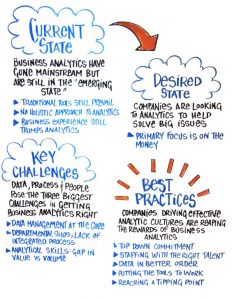Since I started getting more involved in process improvement, I’ve started to look differently at how we work and interact with each other, information, knowledge and technologies. In analytics, I typically see processes represented in two ways: From a systems perspective and from a functional perspective. The problem with the systems perspective is that technology architecture diagrams only show a process from the technology view (which is not very meaningful to most business people). Then, in the functional view, you only see how a particular group interacts with a process. Either way, we’re not getting the entire picture.
Let’s say one group creates a predictive model; they finish their work "successfully” and hand the output to another team. Are the next teams in the process as “successful” with one team’s output as an input into their process? Usually not; and then the finger pointing begins when the process doesn’t go smoothly. The factions begin to splinter into “The Business,” “The Analytic Team” and “IT” and the flow of information comes to a grinding halt.
The biggest barrier to effective information flow is the organization itself. Most organizations operate in a matrix structure. Each functional area may have its own set of performance goals and incentives; cross-organizational workstreams have been divided into narrowly defined roles and responsibilities embedded across these functional areas. You can improve a tiny piece of a process in this structure, but because teams only know their piece, they can’t influence major improvements. The workflow is so granular and divided that handoffs, redundancies and errors are almost impossible to address.
 I am working with a company now on continuous process improvement for marketing campaign management. There are five teams involved, 103 process steps - and from idea generation to execution, the process takes 111 days – and that’s if everything goes as planned. An error in their workflow (which was rife with data quality issues, inconsistent quality control mechanisms and an insane amount of handoffs between teams), could result in rework that set the process back two to three weeks.
I am working with a company now on continuous process improvement for marketing campaign management. There are five teams involved, 103 process steps - and from idea generation to execution, the process takes 111 days – and that’s if everything goes as planned. An error in their workflow (which was rife with data quality issues, inconsistent quality control mechanisms and an insane amount of handoffs between teams), could result in rework that set the process back two to three weeks.
Over the past year, they initiated two significant events that have resulted in quantifiable improvements: the first was to take a more process-centric view of the organizational structure – three of the teams were reorganized into a single unit, with unified goals and incentives. The second was to lock all of the stakeholders in a room for two days and map the entire process out. Until the group did this, they actually didn’t know what the entire process was. The mapping exercise gave the group a clear picture of areas for improvement – they identified several quick-hits that could be immediately implemented. This exercise also helped the team identify what additional investments they would need to make (across people, process, data and technology) to move forward with their goal of becoming a world-class marketing analytic organization.
The critical success factor here is the executive leadership needed to cross organizational borders. Without the buy-in of the other process stakeholders, the ability to optimize this process would be largely unsuccessful. The team can certainly identify areas where they can improve quality and workflow for their group, but they won’t have any control over the other aspects of the process.
So why aren’t more organizations taking a harder look at the entire business process and information flow?
